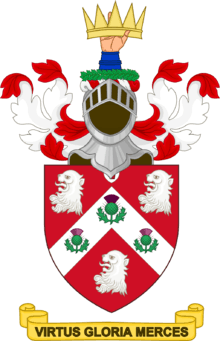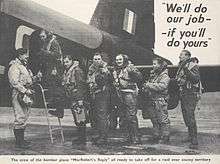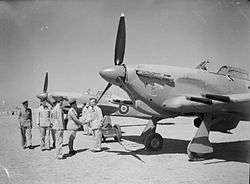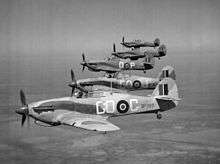MacRobert baronets
The MacRobert Baronetcy, of Douneside in the County of Aberdeen, was a title in the Baronetage of the United Kingdom. It was created on 5 April 1922 for Alexander MacRobert, a self-made millionaire. He was succeeded by his eldest son Alasdair in June of that year. Tragedy struck the family again when Alasdair was killed in a flying accident in 1938, and the title passed to his younger brother Roderic. In May 1941 Roderic was killed in action whilst flying a Hawker Hurricane fighter in the Middle East,[1] and just over a month later on 30 June 1941, the title became extinct when the youngest brother Iain, was also killed in action whilst serving with the Royal Air Force.[2] Their mother, Rachel, Lady MacRobert (1884–1954), gave £25,000 to purchase a Short Stirling bomber, the aircraft was named "MacRobert's Reply" in memory of her three sons. Lady MacRobert believed that her sons had lived up to the family motto Virtutis Gloria Merces – translated as Honour is the Reward of Bravery.[3] The MacRobert Award, which has been presented every year since 1969 by the Royal Academy of Engineering, is named in honour of Lady MacRobert.[4]

The Flight Of The Eaglets
Pipe Major W. Ross composed the slow march (or lament) in memory of Lady MacRobert's three sons in 1944. It is in the Scots Guards Standard Settings Of Pipe Music 1954, page 70. Also played by Angus Grant, the Lochaber Fiddler.
MacRobert's Reply
After the deaths of the three Macrobert brothers in RAF service, their mother, Lady Rachel Workman MacRobert, wanted to honour and commemorate them. She donated £25,000 to buy a Short Stirling bomber, which was named 'MacRobert's Reply'.

The plane had serial number N6086 and had the MacRobert coat of arms painted on its nose. The plane was handed over to her crew at RAF Wyton on October 10, 1941, with Lady MacRobert attending the naming ceremony. She was assigned to No. XV Squadron and was given the code "LS-F" ("LS", the squadron code for No. 15 Squadron, and "F for Freddie"). The aircraft flew twelve missions, from October 1941 through January 1942. On 7 February 1942, the plane veered off during take-off at RAF Peterhead, and collided with a damaged Supermarine Spitfire.
After this accident, a second Short Stirling, serial number W7531, was named 'MacRobert's Reply'. It was not officially named 'MacRobert's Reply', until after entering service in March 1942. The aircraft was lost during a minelaying raid against the Øresund in May 1942; it was brought down by anti-aircraft fire and crashed into Gals Klint Forest, near the town of Middelfart. Only one member of the crew, Sergeant Donald Jeffs, survived the crash. With the loss of the second Stirling the 'MacRobert's Reply' tradition ended.
In April 1982, the tradition was revived by No. XV Squadron with the naming of Hawker Siddeley Buccaneer S.2B XT287 (coded "F") as 'MacRobert's Reply', the MacRobert family crest was also added onto the fuselage below the cockpit canopy.[5] Squadron Leader Peter Boggis (who was the first pilot to fly the original 'MacRobert's Reply') unveiled the aircraft at No. XV Squadron's former base RAF Mildenhall.[5][6]
No. XV Squadron maintained the tradition when it converted to the Panavia Tornado in 1983 with Tornado GR.1B ZA446 ("F") bearing the 'MacRobert's Reply' name and MacRobert family crest.[7] Over the next 34 years another three Tornados bore the name and crest (ZA559, ZA602 and ZD741) until the squadron disbanded on 31 March 2017.[8] The last 'MacRobert's Reply' Tornado GR.4 ZD741 made its final flight on 25 January 2018 to RAF Leeming and was scrapped in October 2018, bringing an end to the tradition.[9][10]
The MacRobert Fighters


Lady MacRobert also sponsored four Hawker Hurricanes, three named after her sons and the fourth honouring the fighting spirit of the Russian allies.[11] They were handed over to No. 94 Squadron, in which Sir Roderic had served, in Egypt on 19 September 1942.[12]
In the 1960s three Slingsby Swallow gliders for the Air Training Corps were named after the MacRobert brothers: Sir Alasdair, Sir Iain and Sir Roderic.
On 8 November 2017, Eurofighter Typhoon FGR4 ZJ919 of No. 6 Squadron at RAF Lossiemouth had the markings of 'The MacRobert Fighter - Sir Roderic' added on the side fuselage below the cockpit canopy, thus maintaining the connection between the MacRobert family and RAF Lossiemouth following the disbandment of No. XV (Reserve) Squadron which had operated the flagship of the squadron's Tornado GR4 fleet 'MacRobert's Reply'.[13]
Aircraft
- MacRobert's Reply
- Short Stirling Mk.I N6086, (LS-F) operated by No. XV Squadron.
- Short Stirling Mk.I W7531, (LS-F) operated by No. XV Squadron.
- Hawker Siddeley Buccaneer S.2B XT287 (F), operated by No. XV Squadron.
- Panavia Tornado GR.1B ZA446 (F), operated by No. XV Squadron.
- Panavia Tornado GR.1 ZA559 (F), operated by No. XV Squadron.
- Panavia Tornado GR.4(T) ZA602 (F), operated by No. XV (R) Squadron.
- Panavia Tornado GR.4 ZD741 (LS-F), operated by No. XV (R) Squadron.
- Sir Iain
- Hawker Hurricane Mk.IIc HL851 operated by No. 94 Squadron.
- Slingsby Swallow glider for the Air Training Corps.
- Grob Vigilant T.1 ZZ192, operated by No. 2 Flying Training School.[14]
- Sir Roderic
- Hawker Hurricane Mk.IIc HL735 operated by No. 94 Squadron.
- Slingsby Swallow glider for the Air Training Corps.
- Grob Vigilant T.1 ZJ967, operated by No. 2 Flying Training School.[14]
- Eurofighter Typhoon FGR4 ZJ919, operated by No. 6 Squadron, with 'The MacRobert Fighter - Sir Roderic' marking on front side fuselage below cockpit canopy.
- Sir Alasdair
- Hawker Hurricane Mk.IIc HL844 operated by No. 94 Squadron.
- Slingsby Swallow glider for the Air Training Corps.
- One Hurricane commemorating Russian allies operated by No. 94 Squadron.
MacRobert baronets, of Douneside (1922)
- Sir Alexander MacRobert, 1st Baronet (1854–1922)
- Sir Alasdair Workman MacRobert, 2nd Baronet (1912–1938)
- Sir Roderic Alan MacRobert, 3rd Baronet (1915–1941)
- Sir Iain Workman MacRobert, 4th Baronet (1917–1941)
References
- http://www.cwgc.org/find-war-dead/casualty/2170242
- http://www.cwgc.org/find-war-dead/casualty/1079764
- http://www.aoth17.dsl.pipex.com/mrr/history1.htm
- The MacRobert Trust
- "XV SQUADRON & MACROBERT'S REPLY". XV Squadron Association. Retrieved 27 February 2019.
- "Obituary: Peter Boggis". The Scotsman. Edinburgh. 11 July 2010. Retrieved 27 February 2019.
- Napier, Michael (2017). Tornado GR1: An Operational History. Barnsley: Pen & Sword Aviation. p. 236. ISBN 1473873029.
- Paterson, Niall (26 February 2017). "XV(R) Squadron Photo Event". Aero Resource. Retrieved 27 February 2019.
- "Displaying Serials in range ZD". UK Serials Resource Centre. Wolverhampton Aviation Group. Retrieved 27 February 2019.
- "Aircraft airframes and disposal of Tornado hulks" (PDF). Ministry of Defence. 28 September 2018. Retrieved 27 February 2019.
- "MacRobert Aircraft – A Woman's Courage And Sacrifice" in The Argus, Melbourne, 16 January 1943
- "AIRCRAFT OF THE ROYAL AIR FORCE 1939-1945: HAWKER HURRICANE". Imperial War Museum. Retrieved 27 February 2019.
- "First Secretary salutes RAF Lossiemouth contribution to UK Defence". gov.uk. Ministry of Defence. 8 November 2017. Retrieved 27 February 2019.
- "Grob Vigilant". Wolverhampton Aviation Group. Retrieved 27 February 2019.